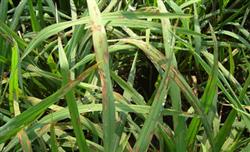Occurrence and control of rice blast and rice planthopper

First, the occurrence of rice blast: Rice leaf blast has appeared in Helan, Qingtongxia and other places. The initial period is June 13, about 10 days earlier than last year. Especially after the rainfall on July 7 and 12, the humidity in the field is relatively high, which is very beneficial to the development of leaf blast. In the recent general survey of Qingtongxia, the average rate of diseased fields was 16.7%, the rate of diseased plants was 2.2%, and the rate of diseased leaves was 0.68%. Helan occurred sporadically in some strip sowing fields. The panicle neck blast will appear at the end of July and the beginning of August. The weather forecast shows that the temperature of the whole region is higher and the precipitation irrigation area is less in August, which is disadvantageous to the occurrence and development of the panicle neck blast. It is expected that the occurrence of panicle neck blast is moderate to mild in general, and moderate to heavy in the fields with large planting area of locally susceptible varieties. In spite of this, various rice counties should not be taken lightly, and monitoring should be strengthened. For fields with disease centers, farmers should be immediately organized to spray to block the disease centers and control the spread of bacteria spores. In the middle and last ten days of July, the fields with high density and prosperous growth were widely controlled to control the development of leaf blast and prevent the occurrence of panicle blast. In the early and middle of August, the fields with panicle and neck blast were sprayed in time to control the spread of the disease. Rice planthopper: Wu Zhong investigated the hole rate of 42% on July 10. 50 times, 32 brown-backed planthoppers, 10 white-backed planthoppers, 37 long-winged and 5 short-winged adults. There were 60 white-backed planthoppers and 151 brown-backed planthoppers. 24 insects per 100 clumps were investigated in Qingtong Gorge on July 10. Second, the methods of prevention and control can adopt the methods of "treating both diseases and insect pests" and "one spray and multiple prevention". The disease control agents are mainly tricyclazole, rice disinfectant and other broad-spectrum fungicides, while the control agents of rice planthopper are imidacloprid and acetamiprid. In the control of rice planthopper, attention should be paid to the application time and method. When the rice planthopper is active in the upper part of the plant before 10:00 or after 4 o'clock in the afternoon, it should be sprayed to the lower part of the rice plant as far as possible, with 60 kg water per mu. Carry out unified prevention and control of the fields with serious harm caused by mixing, and give full play to the role of motorized sprayers and large vehicle-mounted sprayers.
- Prev

Classification standard and control method of rice blast
Grading standard leaf plague: 1 sporadic occurrence, careful investigation can see the disease 2 slightly more, the disease leaves concentrated in the lower 3 widespread, the disease leaves concentrated in the middle and lower 4 more serious, the disease leaves concentrated in the middle and upper, a small amount of pond 5 serious, there are obvious pond...
- Next

Occurrence characteristics and control techniques of rice false smut
1. Occurrence characteristics of rice false smut disease only occurs in panicle, generally from flowering to milk ripening of rice. The infected grain grows in glume and forms rice false smut with a diameter of about 1 cm instead of rice grain. The optimum temperature for germination and development of Ustilaginoidea virens was 25~30℃, 34℃ or 12 ℃.
Related
- The first cup of black tea in spring, the flavor and history of tea gardens in Kenya, Africa
- The computer can not only choose potatoes, but also grow tea rice. AI will grow winter oolong tea champion.
- It is not only the inflated tea bitten by insects, but also engraved with the four seasons tea in Beipu.
- The Oriental Beauty Tea Festival in Zhuxian County takes the stage at the weekend to experience the plus-size feast of oil tea.
- & quot; Oriental Beauty Tea & Exploration of Emei in Hsinchu, the hometown of quot;
- The new variety of strawberry "Tainong 1" dessert is the first choice with mellow aroma. Crimson gorgeous
- History of Tea in Taiwan: from Wild Inner Mountain to Export Tea Garden
- Two types of Taiwan Oriental Beauty Black Tea won the British three-Star Award for Childhood Tea Xiang Zhang Jiaqi changed from pilot to champion tea maker.
- Banana species and varieties: the planting history of Taiwan Xianren banana and dwarf banana is long, is banana disease resistant?
- Coffee planting Technology: Qianjie Coffee from Seedling to harvesting

